State’s last surviving Tuskegee Airman visits Academy for ceremony
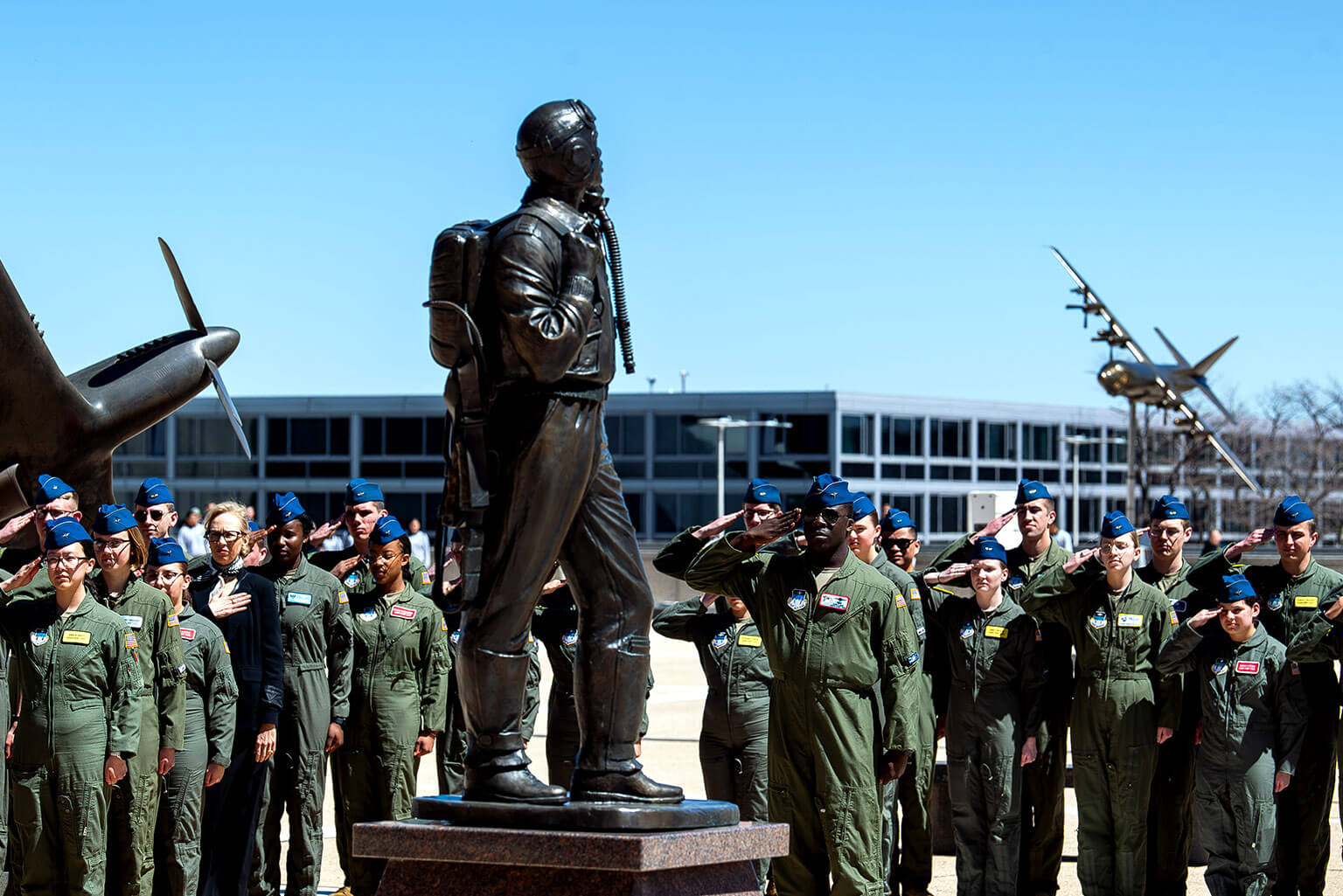
Cadets stand in formation during the Tuskegee Airman statue re-dedication and wreath-laying ceremony at the U.S. Air Force Academy’s Honor Court April 12, 2024. Retired U.S. Air Force Col. James H. Harvey, Colorado’s only surviving Tuskegee Airman, and Peggy Shivers, the wife of the late Tuskegee Airman and statue creator Lt. Col. Clarence Shivers, also attended the ceremony. (U.S. Air Force photo by Trevor Cokley)
By Randy Roughton
U.S. Air Force Academy Strategic Communications
U.S. Air Force Academy, Colo. – Colorado’s lone surviving documented original Tuskegee Airman returned with other family members of the famed African American aviators to help rededicate the statue that honors their legacy.
Retired U.S. Air Force Col. James H. Harvey and Peggy Shivers, the wife of the late Tuskegee Airman Lt. Col. Clarence Shivers, attended the U.S. Air Force Academy’s Tuskegee Airmen statue rededication and wreath-laying ceremony in the Honor Court April 12. Shivers created the Academy’s life-sized “Tuskegee Airmen of World War II” statue that was unveiled in 1998. The Denver Chapter of Tuskegee Airmen commissioned the sculpture in 1985.
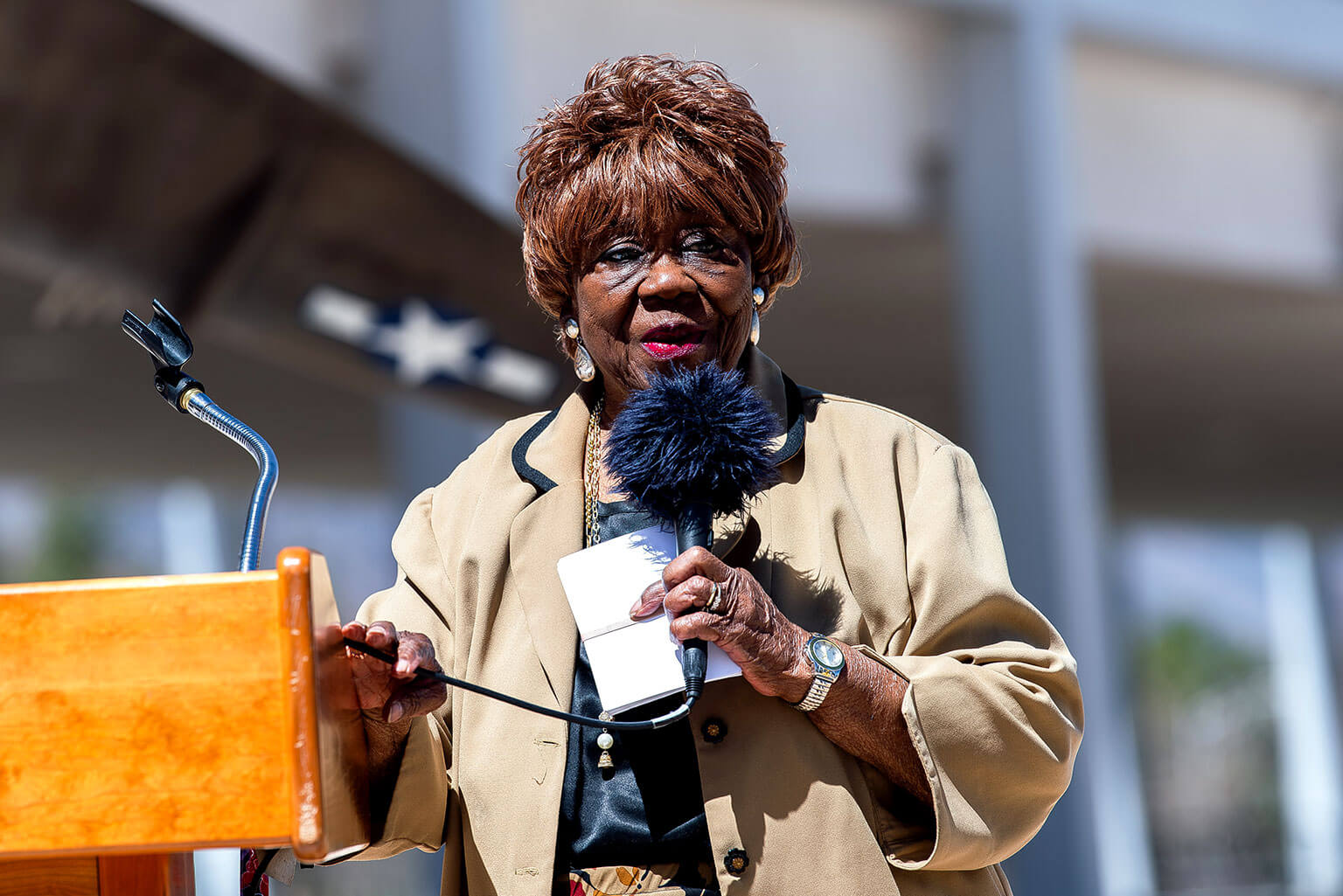
Peggy Shivers speaks at the Tuskegee Airmen statue re-dedication and wreath-laying ceremony at the U.S. Air Force Academy’s Honor Court April 12, 2024. Shivers is the wife of the late Tuskegee Airman and statue creator Lt. Col. Clarence Shivers. (U.S. Air Force photo by Trevor Cokley)
Honoring the statue sculptor at the re-dedication ceremony
After the ceremony, Academy leadership added a plaque honoring Shivers to the statue. The Academy leadership wanted to ensure that the statue’s creator was properly credited and acknowledged for his work.
The plaque reads: “The Tuskegee Airman statue you see before you was created by original Tuskegee Airman Lt. Col. Clarence L. Shivers, USAF (Ret.). Shivers graduated from Class SE-44-J on December 28, 1944.”
Shivers said she was touched by the ceremony. She reminisced about watching her husband work diligently with the clay to create the stature that now stands on the southwest corner of the Honor Court.
“I knew this statue when it was nothing but clay,” Shivers said. “I saw it progress and progress. He wanted it to show a proud black man because all the Tuskegee Airmen were so proud of what they were doing.”
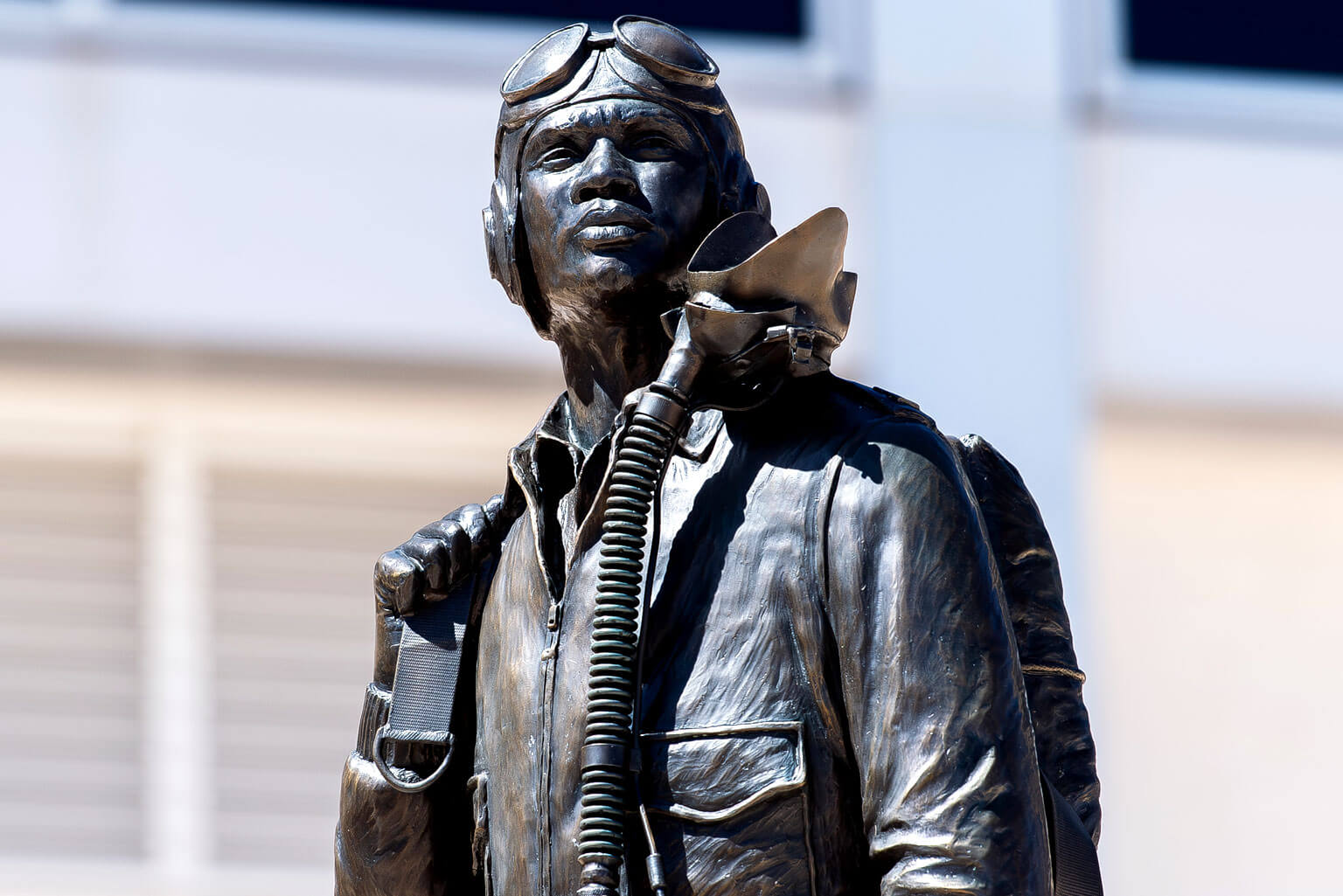
The Tuskegee Airman statue is pictured at the U.S. Air Force Academy Honor Court April 12, 2024. Retired U.S. Air Force Col. James H. Harvey, Colorado’s only surviving Tuskegee Airman, and Peggy Shivers, the wife of the late Tuskegee Airman and statue creator Lt. Col. Clarence Shivers, attended the statue re-dedication and wreath-laying ceremony. (U.S. Air Force photo by Trevor Cokley)
From the Tuskegee Airmen to Korean airspace
Harvey, now 100, was promoted to colonel during halftime at the Academy football game vs. Army in Denver Nov. 4, 2023. He flew the P-47 Thunderbolt as a member of the original Tuskegee Airmen in the 332nd Fighter Group during World War II. Harvey later became one of the first African American fighter pilots to fly in Korean airspace in 1950. In 1965, Harvey retired after a 22-year U.S. Air Force career that included 11 Air Medals.
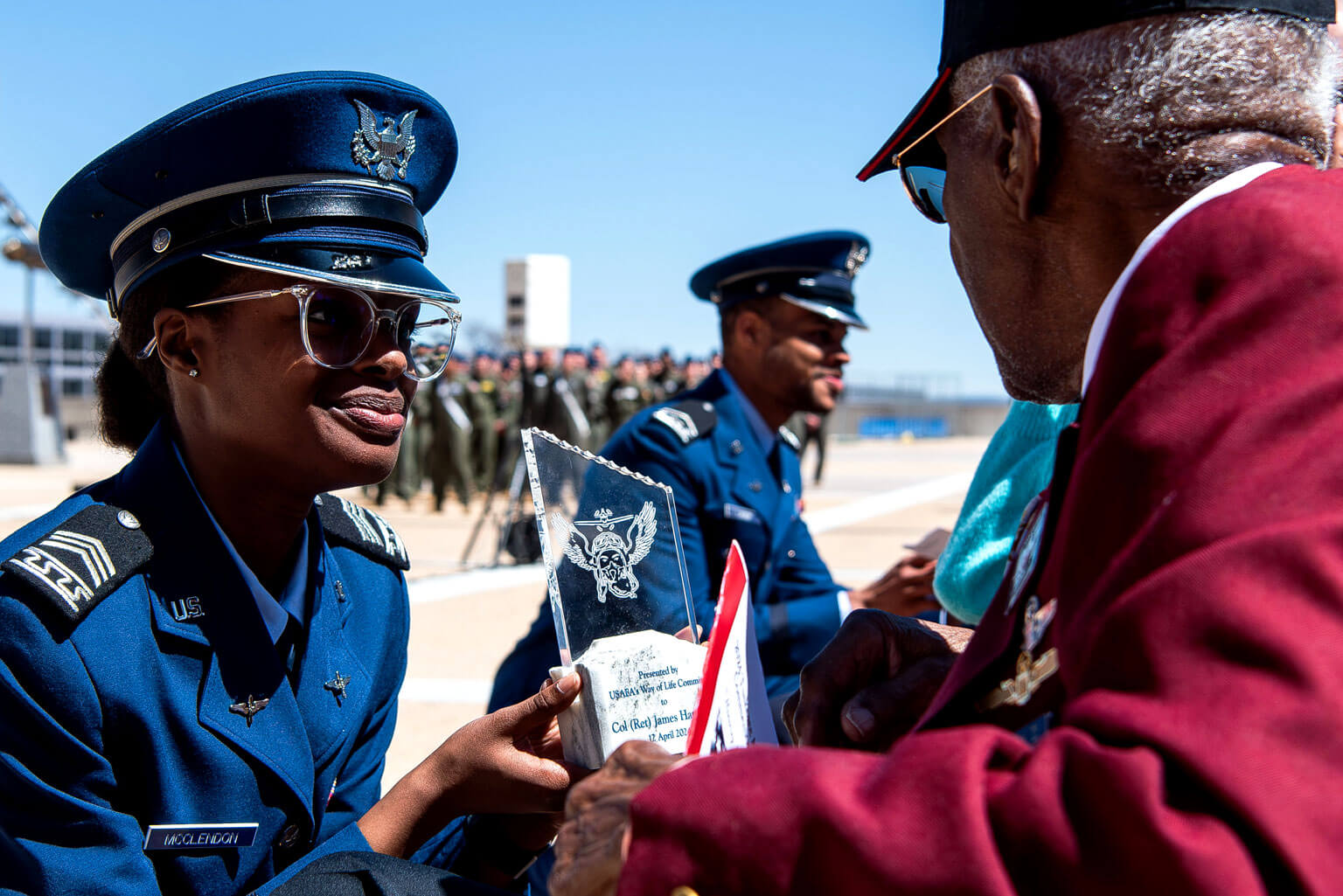
Cadet 2nd Class Jadoria McClendon presents a plaque from the Way of Life Committee to retired Col. James H. Harvey, Colorado’s only surviving documented original Tuskegee Airman, at the U.S. Air Force Academy’s Honor Court April 12, 2024. Peggy Shivers, the wife of Tuskegee Airmen statue creator Lt. Col. Clarence Shivers, also attended the statue re-dedication and wreath-laying ceremony. (U.S. Air Force photo by Trevor Cokley)
The Tuskegee legacy
The success of the Tuskegee Airmen in the 332nd Fighter Group during World War II, named for their training at Tuskegee Army Air Field, Alabama, helped lead the way for racial desegregation in the armed forces. The 332nd flew more than 3,000 missions in Europe and destroyed almost 300 enemy planes, according to National Archives and Records Administration records. Almost 90 of the group’s pilots received the Distinguished Flying Cross.
They escorted bomber aircraft in some of the most perilous missions in the European theater of operations. One of those missions was the March 24, 1945, “Long Haul to Berlin.” The “Red Tails” escorted 15th Air Force B-17 Flying Fortress aircraft on a 1,600-mile bombing mission in Berlin. Three years after the war ended, President Truman’s Executive Order 9981 ultimately mandated the military’s desegregation in 1948.

U.S. Air Force Academy Superintendent Lt. Gen. Richard Clark displays his replica of the P-51 Mustang in his office Dec. 8, 2023. On April 12, Clark spoke at the re-dedication and wreath-laying ceremony for the Tuskegee Airmen statue, attended by Colorado’s only surviving original Tuskegee Airman, retired Col. James H. Harvey. (U.S. Air Force photo by Justin Pacheco)
‘The original wingmen’
The statue rededication ceremony, organized by the Hubert L. Hooks Jones chapter and the Academy Way of Life Committee, was intended to honor the Tuskegee Airmen legacy, said Academy Superintendent Lt. Gen. Richard Clark. They were “the original wingmen” who inspired him to become a pilot, he said.
“The Tuskegee Airmen have always played an important role in my story and why I wanted to become a pilot,” Clark said. “I felt represented by these men and admired how they broke barriers despite the discrimination they experienced. Their example inspired me to fly. I have a replica of the P-51 Red Tail that I keep in my office, and it’s one of my most prized possessions. I am so glad these heroes are receiving the recognition they deserve.”
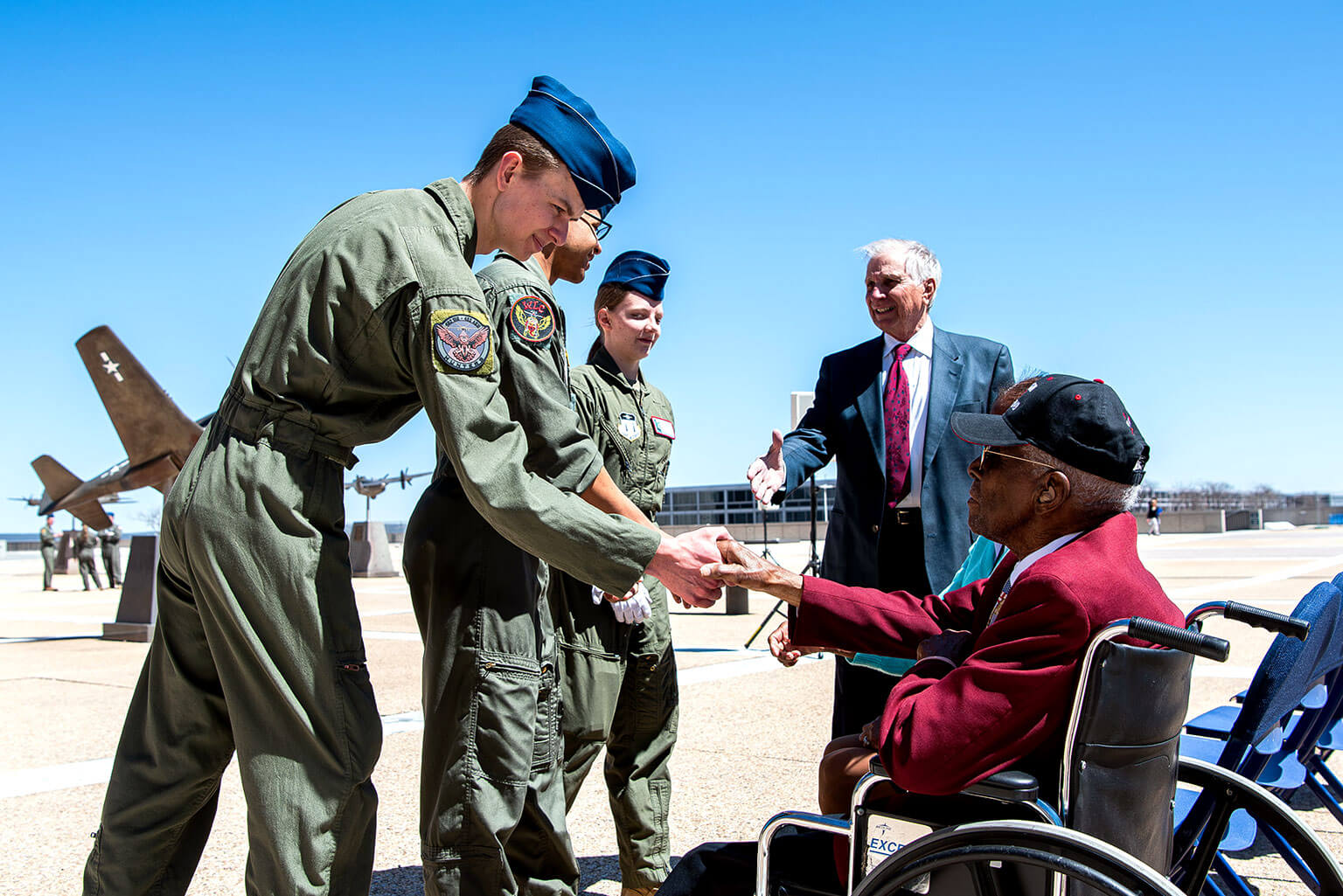
Cadets welcome retired Col. James H. Harvey, Colorado’s only surviving documented original Tuskegee Airman, to the U.S. Air Force Academy’s Honor Court April 12, 2024. Peggy Shivers, the wife of Tuskegee Airmen statue creator Lt. Col. Clarence Shivers, also attended the statue re-dedication and wreath-laying ceremony. (U.S. Air Force photo by Trevor Cokley)
Inspiration for current cadets
The nation’s first African American pilots continue to inspire generations of future Airmen. Members of Cadet Squadron 20 shared their knowledge of the Tuskegee Airman’s legacy with their classmates during Black History Month in 2023, said Cadets 2nd Class Jillian Howe and Julian Jackson after the ceremony. The cadets were sitting together when the topic turned to the Tuskegee Airmen, Jackson said.
“The majority of the table did not know who the ‘Red Tails’ were,” Jackson said. “We told them they were the first documented African American pilots in the armed forces. During that month, we talked about how many missions the Red Tails did, so that sparked a lot of interest.”
Like many in their squadron, Howe and Jackson said they believe they can learn a lot of lessons from learning about the U.S. military’s first African American pilots.
“We can draw a lot of inspiration from the stories of the Red Tails during the war, especially with having to fight barriers such as discrimination,” Howe said. “They pushed the norms and still had success in defending the bombers and sticking together. As Lieutenant General Clark said, they were the original wingmen. They are still an inspiration today and examples that we can follow as a squadron and as cadets.”
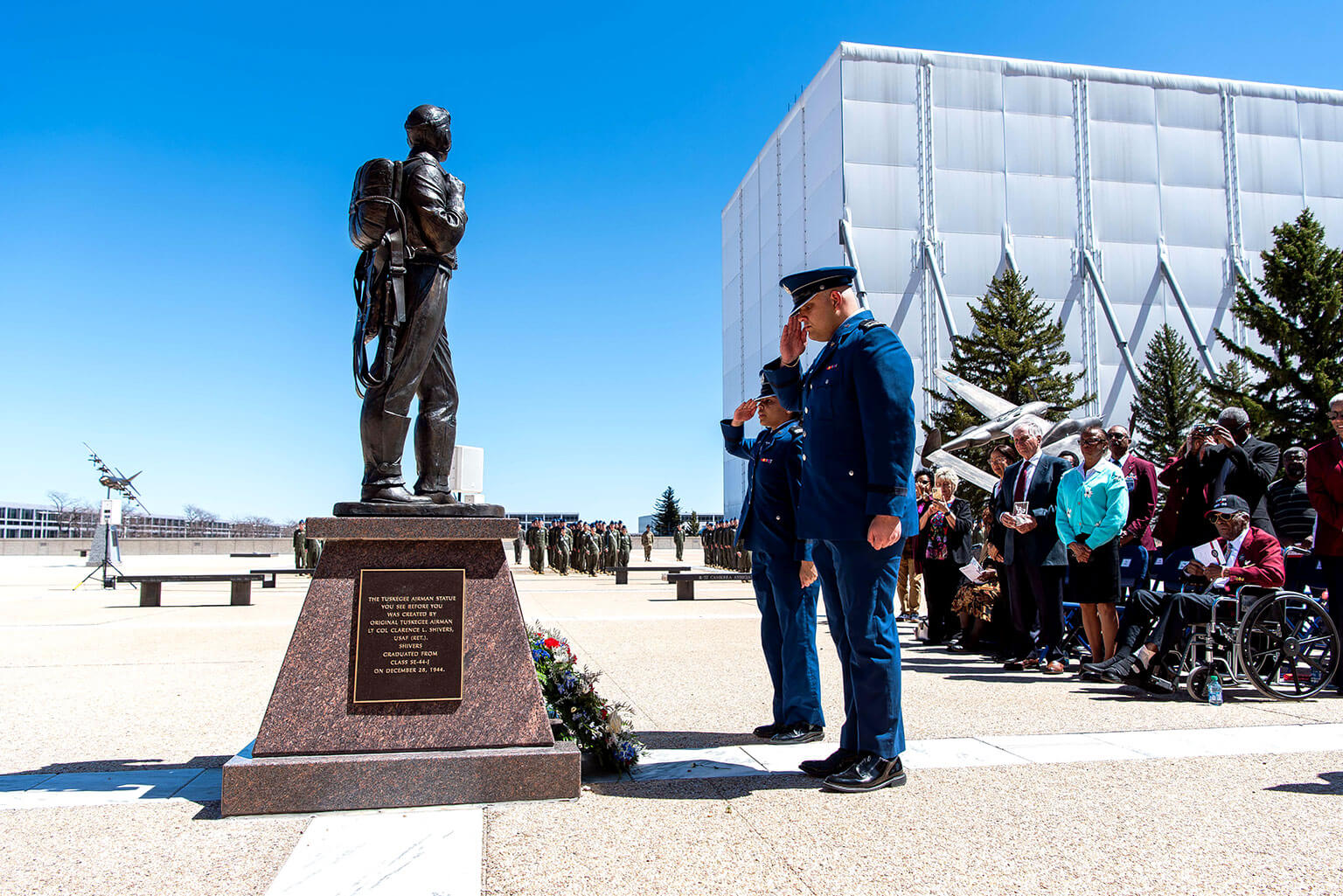
Cadets render salutes after they laid the wreath on the Tuskegee Airmen statue during a re-dedication and wreath-laying ceremony at the U.S. Air Force Academy’s Honor Court April 12, 2024. Retired U.S. Air Force Col. James H. Harvey, Colorado’s only surviving Tuskegee Airman, and Peggy Shivers, the wife of statue creator Lt. Col. Clarence Shivers, also attended the ceremony. (U.S. Air Force photo by Trevor Cokley)
For more photos of the ceremony, see Flickr.